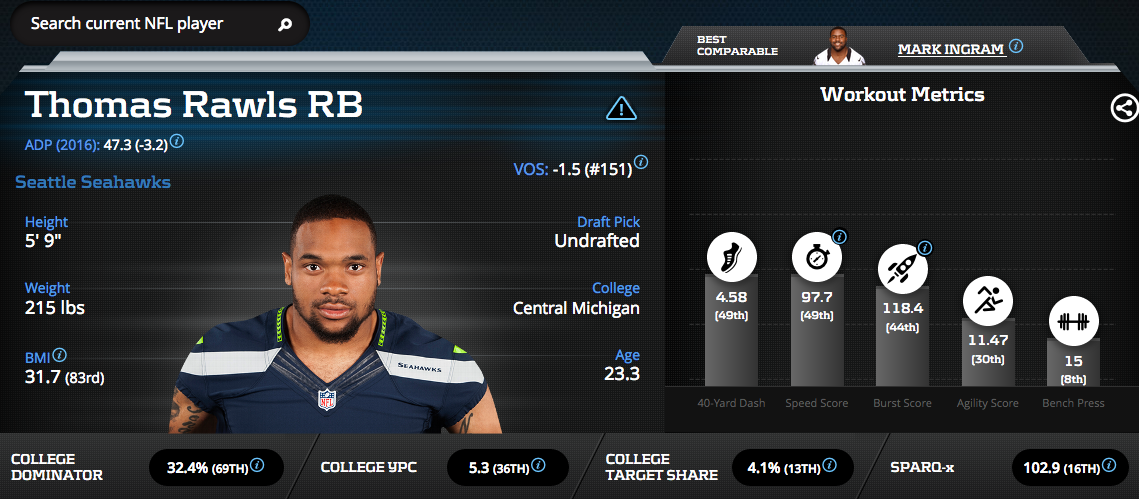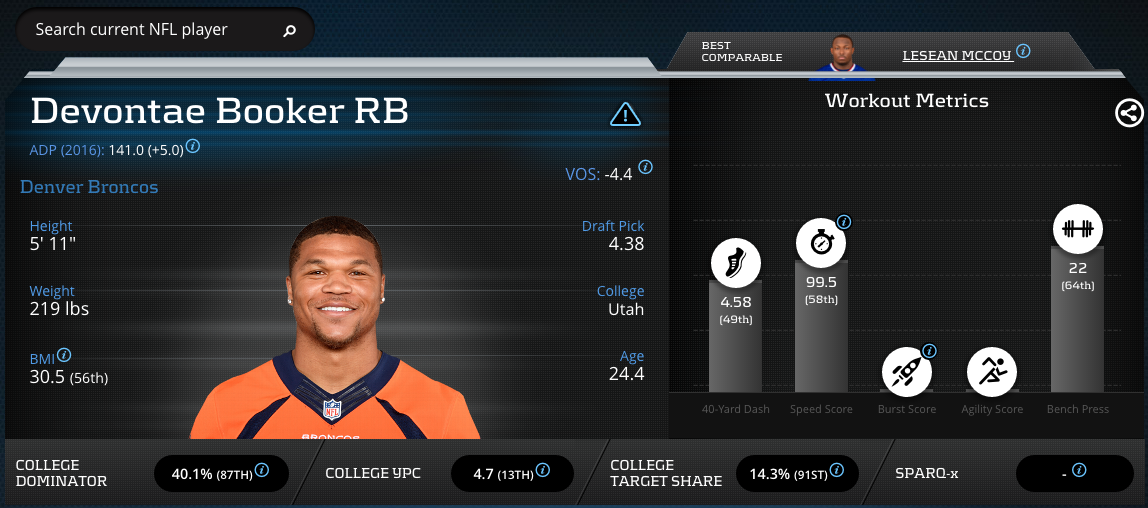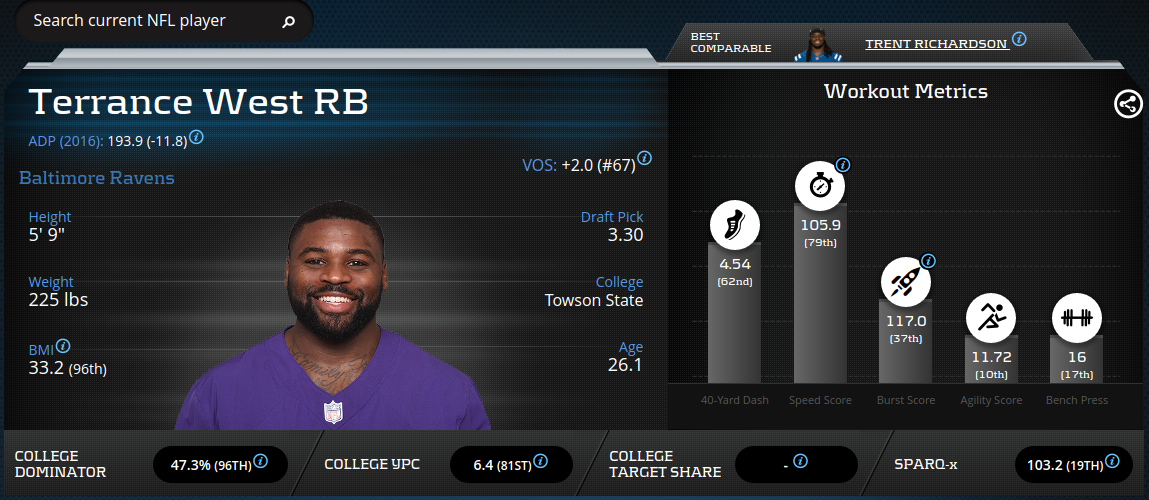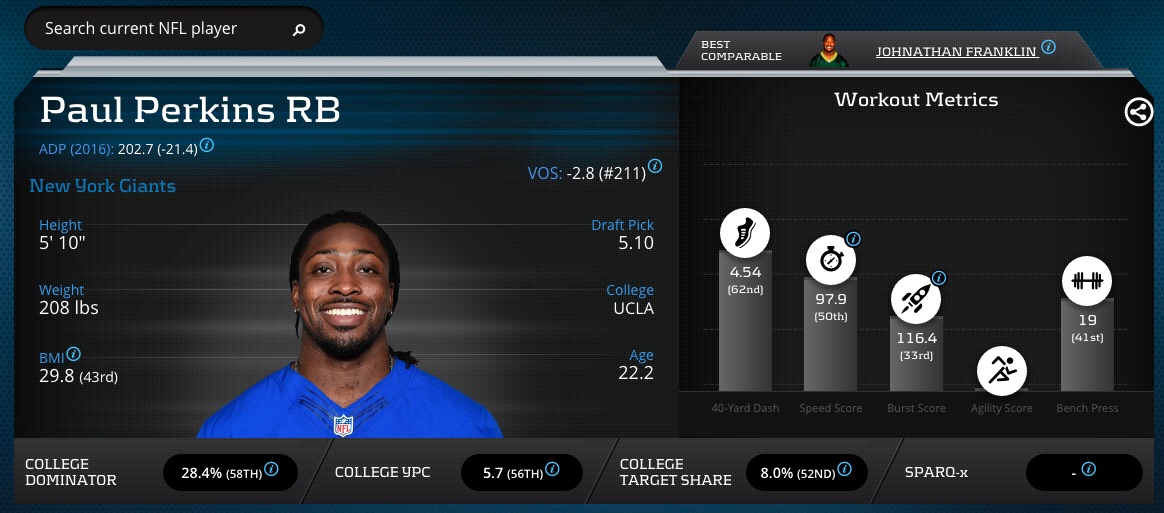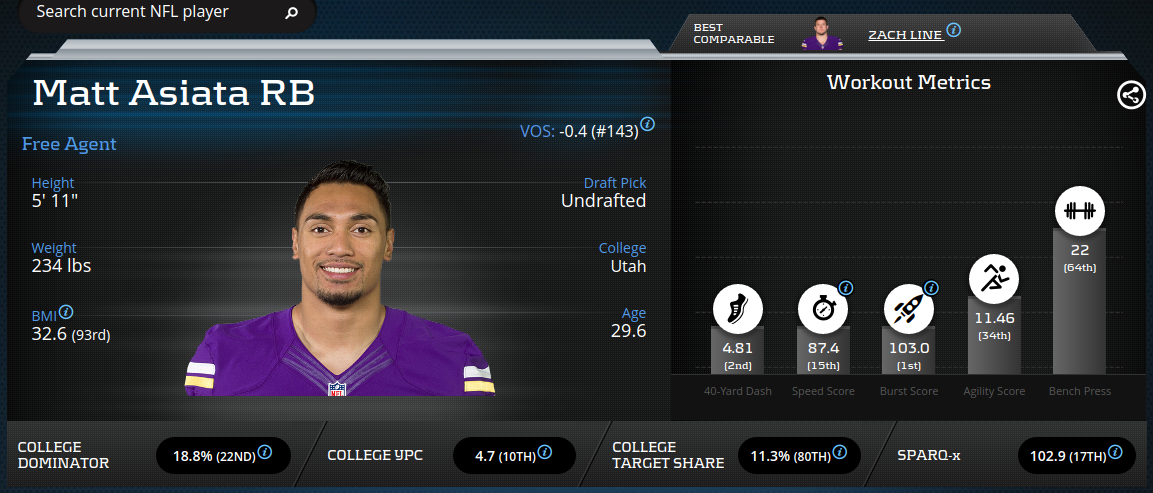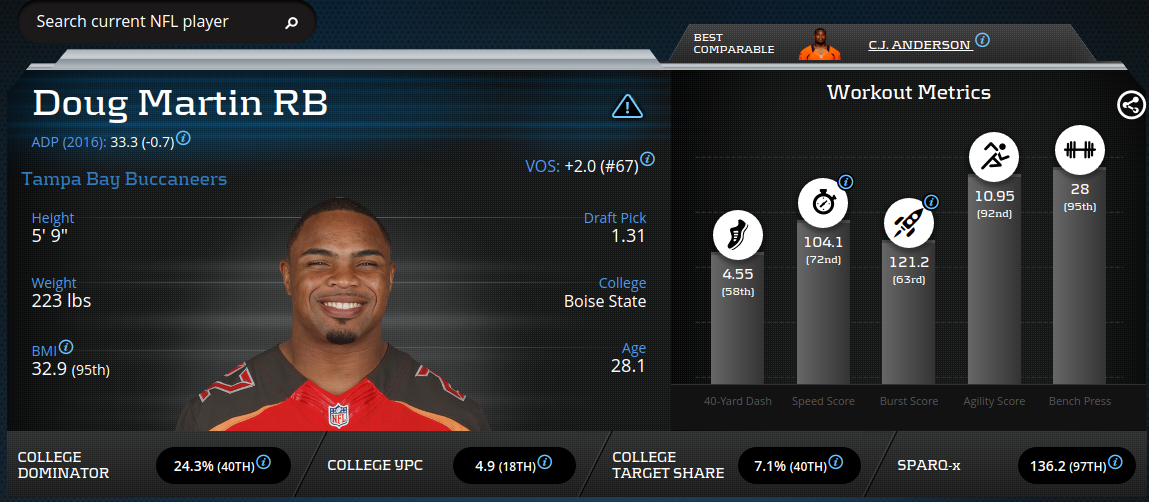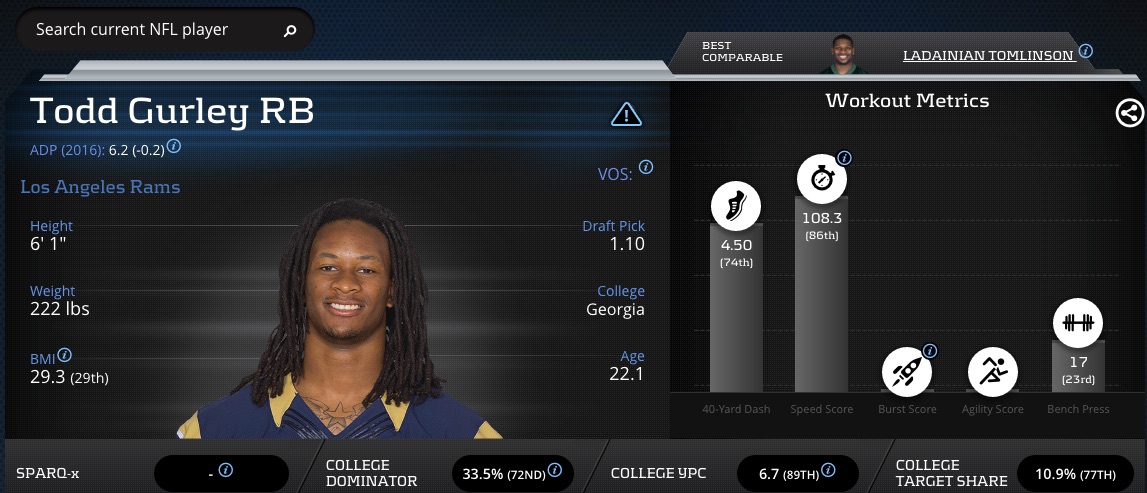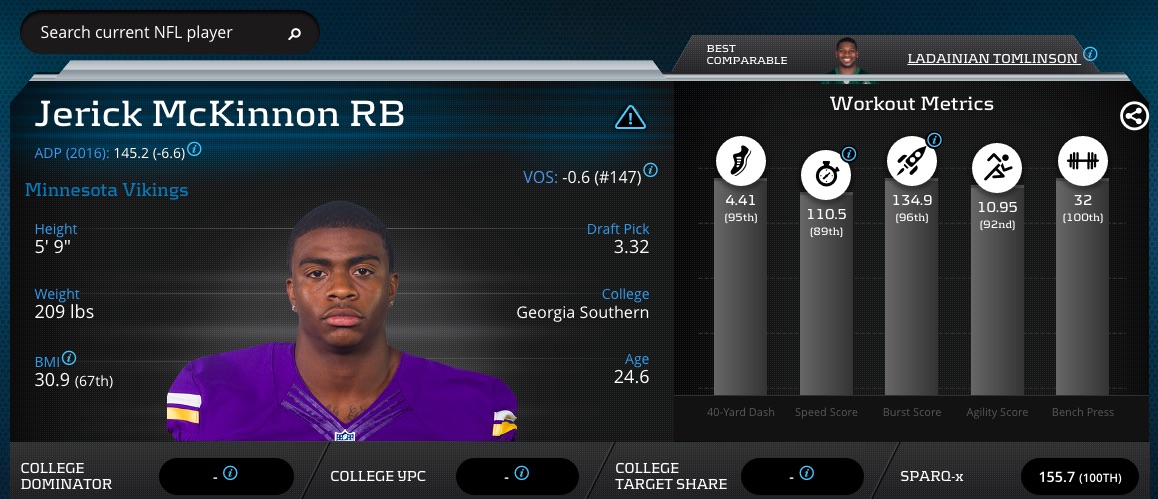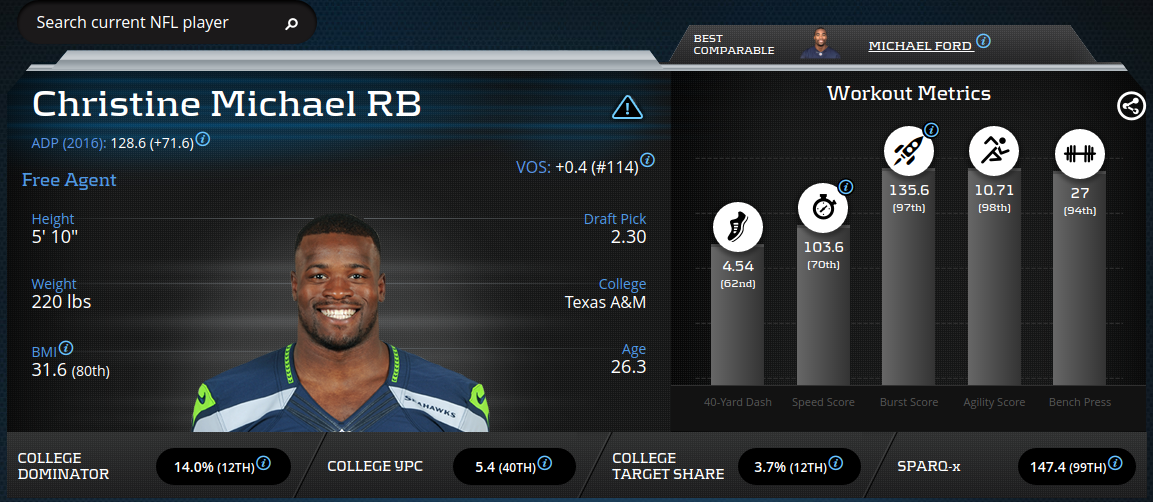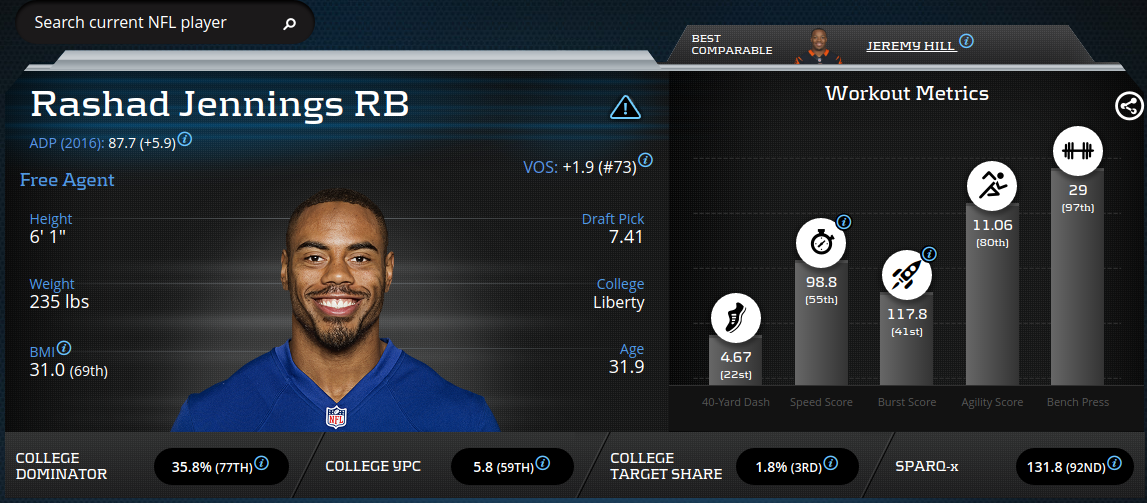After exploring the top running back yards per carry versus base defensive fronts in 2016, we are now compelled to review the least effective running backs against based defenses last season.
As a refresher, Formation-specific Efficiency is new to PlayerProfiler.com in 2017. These metrics illuminate running backs effectiveness versus stacked fronts, base fronts, and heavy fronts. Yards per carry versus base defensive front is defined as a running back’s per carry efficiency against defenses with precisely seven defensive linemen plus linebackers. While the previous piece outlining the top fantasy football running backs against base defenses celebrated the most effective runners from the 2016 season, this article ties warning buoys to the least effective runners as fantasy football enthusiasts look forward to the 2017 season.
Here are your least efficient running backs versus base front defenses in 2016 (min. 100 carries).
12a. Thomas Rawls, Seattle Seahawks: 3.6 YPC
12b. Jacquizz Rodgers, Tampa Bay Buccaneers: 3.6 YPC
12c. Alfred Blue, Houston Texans: 3.6 YPC
12d. Devontae Booker, Denver Broncos: 3.6 YPC
We’ll start our 10th worst YPC ranking with a group of four running backs who under performed in 2016. Jacquizz Rodgers, while he did average 4.3 yards per carry this season, saw his most success coming against light defensive fronts, where he averaged a bulky 7.0 YPC against such a front (No. 5 in 2016). With a career average of 3.8 YPC, and a 2015 season that saw him averaging 2.9 YPC, Jacquizz Rodgers shouldn’t be taken seriously as a threat to any running back’s role, whether it be with the Tampa Bay Buccaneers, or elsewhere in 2017.
We won’t put too much stock into Alfred Blue either. He is at best a second-string running back for the Texans in 2017, and could even drop to third on the depth chart behind the more talented running back, Akeem Hunt who has a 4.44 40-yard dash (90th-percentile), 124.8 Burst Score, (79th-percentile), 10.78 Agility Score (96th-percentile) and 15.4-percent college target share (94th-percentile). Blue, like Jacquizz Rodgers, is another running back with a career YPC under 4.0 (3.6), and isn’t going to overtake a starting position in Houston any time soon. Looking at all of the efficiency metrics on PlayerProfiler from Production Premium to yards per touch to juke rate, Alfred Blue has been the least effective running back in the NFL since he entered the league and is a cut candidate heading into 2017.
Another highly-favored running back among 2016 pre-draft rankings was Thomas Rawls, after he posted an impressive rookie campaign in 2015, only to significantly regress this year. Rawls should have regressed. PlayerProfiler.com’s advanced metrics profile for Thomas Rawls shows all of the areas where he excels at athletically, and in all actuality, Thomas Rawls is not a special athlete by any measure. Not only does he rank below the 50th-percentile in every athletic metric, Rawls also ranks below the 50th-percentile with a 5.3 college yards per carry (36th-percentile) and 4.1-percent college target share (14th-percentile). The coaches at Central Michigan learned to stay away from Thomas Rawls during his career, and the Seahawks would be wise to do the same.
The player on this list who can bounce back in 2017 is Devontae Booker, who found trouble running behind the 26th ranked Denver Broncos run blocking line (77.9). Booker saw an uptick in opportunity when C.J. Anderson went down with an injury, but struggled to turn that opportunity into productivity. He finished his rookie campaign with 612 rushing yards (No. 26 in 2016), and averaged a paltry 3.5 yards per carry.
Rookie inefficiency aside, Devontae Booker is no stranger to high volume boasting a 40.1-percent College Dominator Rating (86th-percentile) and 14.3-percent College Target Share (91st-percentile). The dual threat running back will need a better supporting cast next season to improve on his rookie numbers, but should be better acclimated to the league in his sophomore year.
The biggest threat to Devontae Booker is still incumbent C.J. Anderson, who is expected to return to the team in 2017. Booker is going to be a favorite for those looking to implement the Zero RB strategy in 2017, as his owners will look for another down year from Anderson, and the chance to plug him in to run behind a hopefully improved offensive line.
https://www.youtube.com/watch?v=ipwdkMGfwOc
10a. Terrance West, Baltimore Ravens: 3.5 YPC
10b. Paul Perkins, New York Giants: 3.5 YPC
Terrance West has struggled at the pro level since being drafted in 2014 by the Cleveland Browns. Ironically enough, his best comparable player is also his former teammate, Trent Richardson, who was also drafted that same year by the Browns. Since being drafted, Terrance West has played for the Browns, Tennessee Titans and now the Baltimore Ravens, and finished 2016 as a relatively mediocre back with 774 rush yards (No. 22), 4.4 yards per touch (No. 54), six total touchdowns (No. 25) and 10.7 fantasy points per game (No. 30).
Terrance West‘s athletic profile suggests that he is every bit as average as his career has played out thus far. West is the owner of a 4.54 40-yard dash time (62nd-percentile), 105.9 Speed Score (79th-percentile) and 103.2 SPARQ-x Score (19th-percentile). The most impressive number on West’s advanced metrics profile is his 47.3-percent College Dominator Rating (96th-percentile) and 6.4 YPC at Towson State, a non-BCS school. Of course West dominated at Towson State, he was an elite high school prospect playing against little to no future NFL competition for three years.
Unlike Terrance West, Paul Perkins at least played against top talent while he was enrolled at UCLA, only Paul Perkins was less dominant in college with a 28.4-percent College Dominator Rating (57th-percentile), 5.7 College Yards Per Carry (55th-percentile) and 8.0-percent College Target Share (52nd-percentile).
Paul Perkins was thought to be a sleeper pick among rookies in 2016, only to turn in a sub par rookie campaign in limited action (112 carries for 456 rush yards). His advanced metrics profile features a 4.54 40-yard dash (62nd-percentile), 97.9 Speed Score (50th-percentile), and 116.4 Burst Score (33rd-percentile) suggesting that Paul Perkins will thrive more on high-volume opportunity, than he will athleticism (Jay Ajayi anybody?). He failed to find the end zone in 2016, and is going to be hard pressed for carries when playing with a superstar like Odell Beckham who demands the ball in high leverage situations and an offensive line that gets little push up front evidenced by a 87.7 (No. 24) run blocking efficiency rating in 2016.
https://www.youtube.com/watch?v=RqRpLsDO90k&t=22s
8a. Matt Asiata, Minnesota Vikings: 3.4 YPC
8b. Tim Hightower, New Orleans Saints: 3.4 YPC
I could make a statement that Matt Asiata is one of the slowest, least athletic running backs to ever come through the NFL, and I would be right. His workout metrics tell a sad story. When the Minnesota Vikings ranked No. 4 in the league in run blocking efficiency in 2015 (125.3), and Asiata still averaged 3.9 yards per carry, and then in 2016, he averaged 3.3 yards per carry, behind the worst run blocking offensive line in the NFL evidenced by a 62.9 run blocking efficiency rating on PlayerProfiler. Matt Asiata’s 36 red zone carries and ineffectiveness everywhere else on the field suggests he is merely a one-dimensional goal line back.
Tim Hightower, despite running behind one of the league’s best run blocking offensive line in New Orleans, Hightower only averaged 3.4 YPC against base defensive fronts, while his teammate Mark Ingram finished 2016 with the 4.7 (No. 6) YPC versus base fronts. While Hightower did have four games in which he eclipsed 100-plus total yards of offense, the Saints remained loyal to the more efficient Ingram in the second half of 2016, and all but phased Tim Hightower out of the game plan, just as quickly as they worked him into it.
7. Jonathan Stewart, Carolina Panthers: 3.4 YPC
Jonathan Stewart entered the league with an impressive advanced metrics profile, posting a 4.48 40-yard dash (80th-percentile), 116.7 Speed Score (97th-percentile), and 126.1 Burst Score (84th-percentile), but at almost 30-years old, he just isn’t the same player he was even as recently as 2015. After finishing 2015 in the top-15 fantasy running backs, Stewart’s 11.4 fantasy points per game fell out of the top-25 in 2016. Though the Carolina Panthers’ offensive line posted a 103.5 (No. 11) run blocking efficiency rating in 2016, Jonathan Stewart could only muster 3.4 yards per carry against base defensive fronts and 3.8 yards per carry overall on the season.
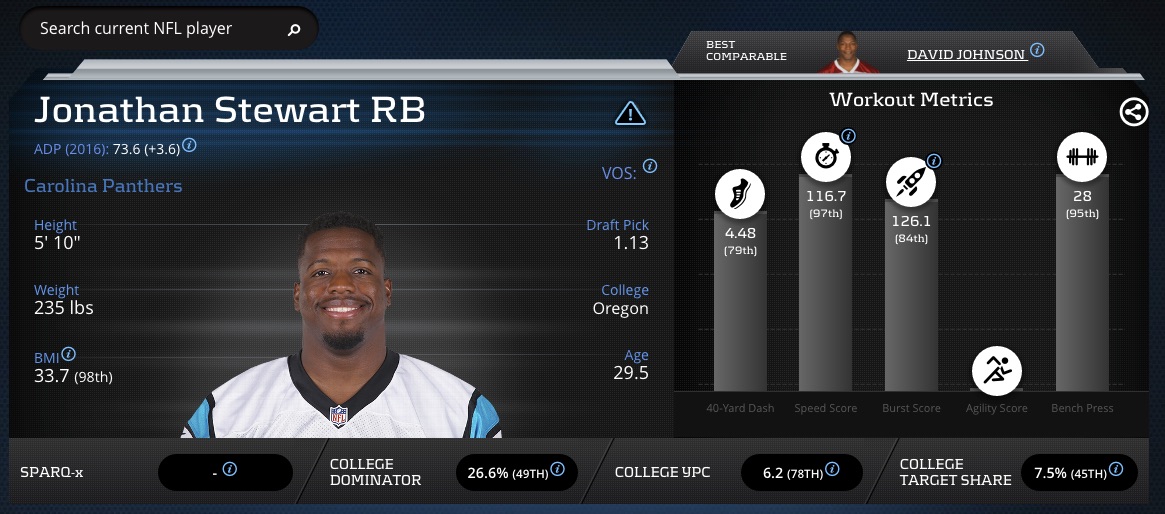
Jonathan Stewart Advanced Stats & Metrics Profile
The Panthers should use early round draft capital on an incoming rookie running back at the 2017 NFL Draft and begin the phasing out process of Jonathan Stewart, who will turn 30 in March.
6. Doug Martin, Tampa Bay Buccaneers: 3.2 YPC
What the heck happened to Doug Martin in 2016? First he was injured for six games, which has come to be expected of him, and then on December 28th, it was announced that he was going to be suspended for four games. Just like that, Martin missed the final two weeks of the 2016 season and will miss Week 1 and Week 2 in 2017. Doug Martin is one of the most perplexing players for fantasy analysts to evaluate heading into 2016.
At 28-years old, Doug Martin may still has a modicum of speed and quickness remaining. However, Martin’s 3.2 YPC vs. base defensive fronts in 2016 suggests his 104.1 Speed Score (72nd-percentile), 10.95 Agility Score (92nd-percentile) and 136.2 SPARQ-x Score (97th-percentile) are relics of long lost athleticism. Martin is one of the NFL’s most likely cut candidates this offseason.
5. Todd Gurley, Los Angeles Rams: 3.1 YPC
The biggest bust of the 2016 fantasy season had to of been Todd Gurley, whose 12.4 fantasy points per game drastically underperformed last season’s 6.2 ADP.
Just one year prior, Todd Gurley was a top fantasy running back with 1,108 rushing yards (No. 3), 16.1 fantasy points per game (No. 5), 71.4-percent Opportunity Share (No. 7) and 5.18 yards per touch (No. 4), but his production collapsed in 2016: 885 rushing yards (No. 17) and 3.8 yards per touch (No. 75). Gurley powered through a 3.1 YPC against base defensive fronts in 2016 with pure volume evidenced by a 84.0-percent Opportunity Share (No. 2) and 278 carries (No. 5). He found the end zone only six times in 2016 compared to his 10 total touchdowns in 2015, and Gurley is a bounce back candidate heading into 2017.
https://www.youtube.com/watch?v=iOVG47g2BQw
A new head coach in Los Angeles will hopefully go a long way in Todd Gurley‘s improvement for next season, but he’s also going to need to see better quarterback play in 2017 out of Jared Goff. A more aggressive passing attack should hopefully lead to more favorable running situations for Todd Gurley, and his owners will be praying for exactly that heading into next season.
4. Jerick McKinnon, Minnesota Vikings: 3.0 YPC
Is it any coincidence that both Jerick McKinnon and Matt Asiata, who both ran behind the worst run blocking line in the league last season would make this list?The Vikings’ offensive line was absolutely horrendous in 2016, and it’s no wonder that their 5-0 start eventually eroded to an 8-8 finish and them missing the playoffs. Even Adrian Peterson averaged a paltry 1.9 YPC in the limited action he saw before getting injured (72 rush yards on 37 carries).
Jerick McKinnon might be the only running back on this list who can solely blame poor offensive line play for his less than stellar numbers in 2016. McKinnon is objectively the most athletic running back in the NFL boasting a 4.41 40-yard dash (95th-percentile), 110.5 Speed Score (89th-percentile), 134.9 Burst Score (96th-percentile), 10.95 Agility Score (92nd-percentile), and posted an astounding 32 bench reps (100th-percentile) at the NFL Scouting Combine — exceptional for a running back who stands in at 5-foot-9, weighing 209-pounds. McKinnon’s 155.7 SPARQ-x Score (100th-percentile) fully expresses his sublime athleticism.
Minnesota’s offensive line provided a great disservice to Jerick McKinnon‘s athletic potential last season, as he broke off just two breakaway runs (No. 55) on 159 carries (No. 26). Should Adrian Peterson stay with Minnesota for 2017, McKinnon will find himself as a prime Zero RB candidate for fantasy owners to start the season, and his value will soar if their run game improves from last year’s numbers.
https://www.youtube.com/watch?v=dzAt8Mo4r70&t=182s
3. T.J. Yeldon, Jacksonville Jaguars: 2.9 YPC
So Chris Ivory leads the league in yards per carry versus base front defenses in 2016, while his teammate T.J. Yeldon was the third worst among all running backs with a 100 carry minimum. Go figure.
We’ve come to expect this from T.J. Yeldon, who has become one of the most loathed running backs in fantasy football. Last season, Yeldon could not convert 50 receptions (No. 11 among NFL running backs in 2016) into more than 312 receiving yards (No. 21). His -10.6 Production Premium (No. 55) is just the beginning of what highlighted a brutal 2016 for Yeldon, who totaled only two touchdowns last season, and averaged 4.3 yards per touch (No. 57). He managed only one run of 15-plus yards last season (No. 71), and posted a mere .70 fantasy point per opportunity (No. 57).
Every running back in Jacksonville underwhelmed in 2016, but Chris Ivory did provide a glimmer of hope for 2017. After two inefficient seasons, the T.J. Yeldon blip has disappeared from the fantasy radar.
2. Christine Michael, Seattle Seahawks/Green Bay Packers: 2.5 YPC
Christine Michael is like the Jared Cook of running backs. An incredibly athletic player who can’t convert that athleticism to on-field production.
Since being drafted in the second round of the 2013 NFL Draft by the Seahawks, Christine Michael has been cut by the Seahawks, signed and cut by the Cowboys, signed and cut by the Seahawks again, and then signed halfway through the 2016 season by the Green Bay Packers. Now a free agent, Michael will hope to catch on with a team heading into 2017. While Michael’s athletic profile features a 135.6 Burst Score (97th-percentile), 10.71 Agility Score (98th-percentile) and 147.4 SPARQ-x Score (99th-percentile), his time in the NFL is nearly up.
The verdict on Christine Michael has been out since his time at Texas A&M, where he was unable to post any kind of significant contribution at the collegiate level with a College Dominator Rating of 14.0-percent (12th-percentile), a college yards per carry of 5.4 (40th-percentile) and college target share of 3.7-percent (12th-percentile). It’s safe to say that if you can’t excel in the college game, you likely won’t excel at the NFL level. Michael failed to excel during his four years at Texas A&M and his inability to produce consistently continued into the NFL.
https://www.youtube.com/watch?v=ahX2raAHzP4
1. Rashad Jennings, New York Giants: 2.1 YPC
Is there any chance that the New York Giants knew Rashad Jennings was the worst running back in the league against base front defenses in 2016, and that’s why they released him at the end of the season? Since they probably visit PlayerProfiler.com on a regular basis, the answer is of course, yes.
2016 felt like 31-year old Rashad Jennings‘ final gasp of NFL production. Had it not been for a strong back half of the 2015 season, there’s a chance he wouldn’t have even been in New York at the start of 2016. Instead, Jennings stuck around, received 181 carries (No. 23), and averaged 3.7 yards per touch (No. 77) before being cut at the start of the 2017 offseason. Beyond Jennings’ 2.1 yards per carry against base defensive fronts, his -14.4 Production Premium (No. 62) and 0.62 fantasy points per opportunity (No. 66) suggested Jennings is unlikely to return to fantasy relevance.

